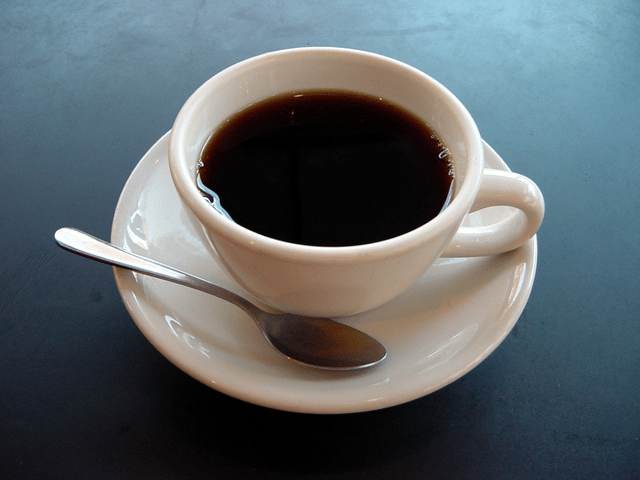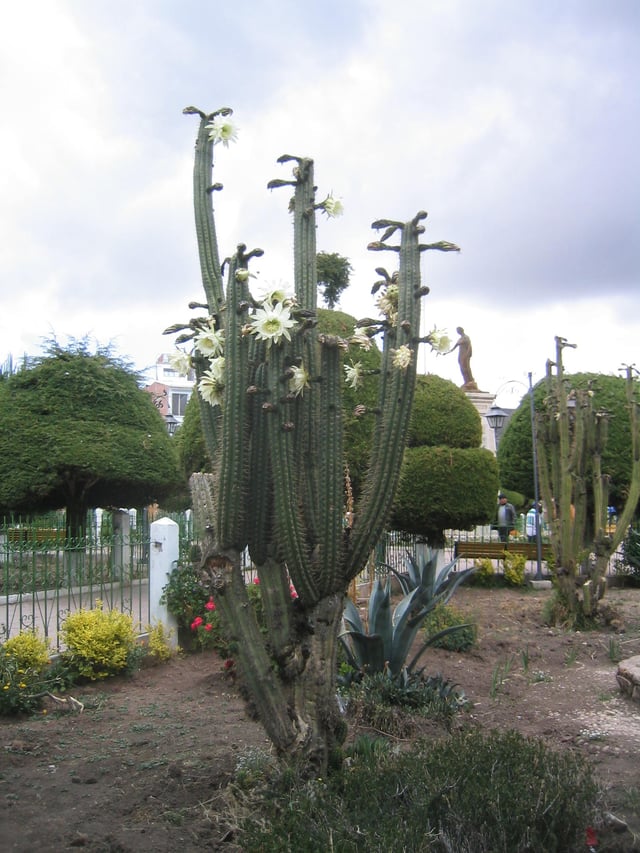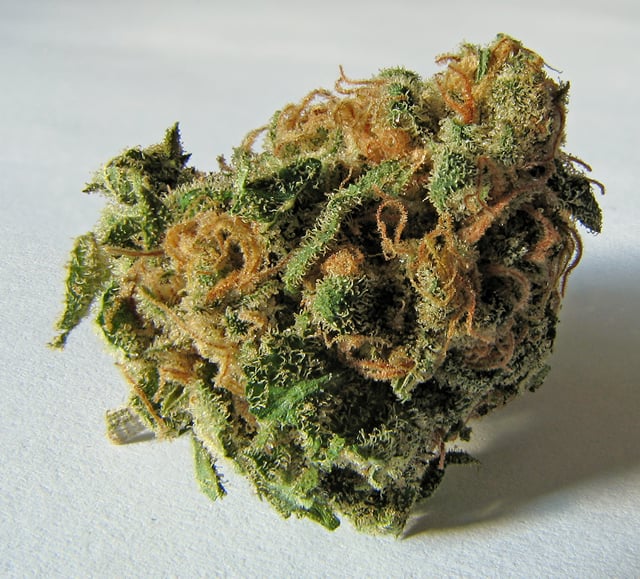Drug

Drug


Uncoated aspirin tablets, consisting of about 90% acetylsalicylic acid, along with a minor amount of inert fillers and binders. Aspirin is a pharmaceutical drug often used to treat pain, fever, and inflammation.
A drug is any substance that causes a change in an organism's physiology or psychology when consumed.[3][4]
Drugs are typically distinguished from food and substances that provide nutritional support. Consumption of drugs can be via inhalation, injection, smoking, ingestion, absorption via a patch on the skin, or dissolution under the tongue.
In pharmacology, a drug is a chemical substance, typically of known structure, which, when administered to a living organism, produces a biological effect.[5] A pharmaceutical drug, also called a medication or medicine, is a chemical substance used to treat, cure, prevent, or diagnose a disease or to promote well-being.[3] Traditionally drugs were obtained through extraction from medicinal plants, but more recently also by organic synthesis.[6] Pharmaceutical drugs may be used for a limited duration, or on a regular basis for chronic disorders.[3]
Pharmaceutical drugs are often classified into drug classes—groups of related drugs that have similar chemical structures, the same mechanism of action (binding to the same biological target), a related mode of action, and that are used to treat the same disease.[8][9] The Anatomical Therapeutic Chemical Classification System (ATC), the most widely used drug classification system, assigns drugs a unique ATC code, which is an alphanumeric code that assigns it to specific drug classes within the ATC system. Another major classification system is the Biopharmaceutics Classification System. This classifies drugs according to their solubility and permeability or absorption properties.[10]
Psychoactive drugs are chemical substances that affect the function of the central nervous system, altering perception, mood or consciousness.[11] These drugs are divided into different groups like: stimulants, depressants, antidepressants, anxiolytics, antipsychotics, and hallucinogens. These psychotropic drugs have been proven useful in treating wide range of medical conditions including mental disorders around the world. The most widely used drugs in the world include caffeine, nicotine and alcohol,[12] which are also considered recreational drugs, since they are used for pleasure rather than medicinal purposes.[13] Abuse of several psychoactive drugs can cause psychological or physical addiction.[14] It's worth noting that all drugs can have potential side effects.[15] Excessive use of stimulants can promote stimulant psychosis. Many recreational drugs are illicit and international treaties such as the Single Convention on Narcotic Drugs exist for the purpose of their prohibition.
Etymology
In English, the noun "drug" is thought to originate from Old French "drogue", possibly deriving later into "droge-vate" from Middle Dutch meaning "dry barrels", referring to medicinal plants preserved in them.[16] The transitive verb "to drug" (meaning intentionally administer a substance to someone, often without their knowledge) arose later and invokes the psychoactive rather than medicinal properties of a substance.[17]
Medication

Nexium (Esomeprazole) is a proton-pump inhibitor. It is used to reduce the production of stomach acid.
A medication or medicine is a drug taken to cure or ameliorate any symptoms of an illness or medical condition. The use may also be as preventive medicine that has future benefits but does not treat any existing or pre-existing diseases or symptoms. Dispensing of medication is often regulated by governments into three categories—* over-the-counter* medications, which are available in pharmacies and supermarkets without special restrictions; behind-the-counter medicines, which are dispensed by a pharmacist without needing a doctor's prescription, and prescription only medicines, which must be prescribed by a licensed medical professional, usually a physician.[18]
In the United Kingdom, behind-the-counter medicines are called pharmacy medicines which can only be sold in registered pharmacies, by or under the supervision of a pharmacist. These medications are designated by the letter P on the label.[19] The range of medicines available without a prescription varies from country to country. Medications are typically produced by pharmaceutical companies and are often patented to give the developer exclusive rights to produce them. Those that are not patented (or with expired patents) are called generic drugs since they can be produced by other companies without restrictions or licenses from the patent holder.[20]
Pharmaceutical drugs are usually categorised into drug classes. A group of drugs will share a similar chemical structure, or have the same mechanism of action, the same related mode of action or target the same illness or related illnesses.[8][9] The Anatomical Therapeutic Chemical Classification System (ATC), the most widely used drug classification system, assigns drugs a unique ATC code, which is an alphanumeric code that assigns it to specific drug classes within the ATC system. Another major classification system is the Biopharmaceutics Classification System. This groups drugs according to their solubility and permeability or absorption properties.[10]
Spiritual and religious use

An Amazonian shaman

San Pedro, a psychoactive cactus
Some religions, particularly ethnic religions are based completely on the use of certain drugs, known as entheogens, which are mostly hallucinogens,—psychedelics, dissociatives, or deliriants. Some drugs used as entheogens include kava which can act as a stimulant, a sedative, a euphoriant and an anesthetic. The roots of the kava plant are used to produce a drink which is consumed throughout the cultures of the Pacific Ocean.
Some shamans from different cultures use entheogens, defined as "generating the divine within"[21] to achieve religious ecstasy. Amazonian shamans use ayahuasca (yagé) a hallucinogenic brew for this purpose. Mazatec shamans have a long and continuous tradition of religious use of Salvia divinorum a psychoactive plant. Its use is to facilitate visionary states of consciousness during spiritual healing sessions.[22]
Silene undulata is regarded by the Xhosa people as a sacred plant and used as an entheogen. Its root is traditionally used to induce vivid (and according to the Xhosa, prophetic) lucid dreams during the initiation process of shamans, classifying it a naturally occurring oneirogen similar to the more well-known dream herb Calea ternifolia.[23]
Peyote a small spineless cactus has been a major source of psychedelic mescaline and has probably been used by Native Americans for at least five thousand years.[24][25] Most mescaline is now obtained from a few species of columnar cacti in particular from San Pedro and not from the vulnerable peyote.[26]
Psychedelic mushrooms (psilocybin mushrooms), commonly called magic mushrooms or shrooms have also long been used as entheogens.
Smart drugs and designer drugs
Nootropics, also commonly referred to as "smart drugs", are drugs that are claimed to improve human cognitive abilities. Nootropics are used to improve memory, concentration, thought, mood, and learning. An increasingly used nootropic among students, also known as a study drug, is methylphenidate branded commonly as Ritalin and used for the treatment of attention deficit hyperactivity disorder (ADHD) and narcolepsy.[29] At high doses methylphenidate can become highly addictive.[30] Serious addiction can lead to psychosis, anxiety and heart problems, and the use of this drug is related to a rise in suicides, and overdoses. Evidence for use outside of student settings is limited but suggests that that it is commonplace.[29][30] Intravenous use of methylphenidate can lead to emphysematous damage to the lungs, known as Ritalin lung.[31]
Some nootropics are also now beginning to be used to treat medical conditions such as Parkinson's disease, and Alzheimer's disease. They are also commonly used to regain brain function lost during aging.
Other drugs known as designer drugs are produced. An early example of what today would be labelled a 'designer drug' was LSD, which was synthesised from ergot.[32] Other examples include analogs of performance-enhancing drugs such as designer steroids taken to improve physical capabilities and these are sometimes used (legally or not) for this purpose, often by professional athletes.[33] Other designer drugs mimic the effects of psychoactive drugs. Since the late 1990s there has been the identification of many of these synthesised drugs. In Japan and the United Kingdom this has spurred the addition of many designer drugs into a newer class of controlled substances known as a temporary class drug.
Synthetic cannabinoids have been produced for a longer period of time and are used in the designer drug synthetic cannabis.
Recreational drug use

Cannabis is a commonly used recreational drug.[34]
Recreational drug use is the use of a drug (legal, controlled, or illegal) with the primary intention of altering the state of consciousness through alteration of the central nervous system in order to create positive emotions and feelings. The hallucinogen LSD is a psychoactive drug commonly used as a recreational drug.[35]
Some national laws prohibit the use of different recreational drugs; and medicinal drugs that have the potential for recreational use are often heavily regulated. However, there are many recreational drugs that are legal in many jurisdictions and widely culturally accepted. Cannabis is the most commonly consumed controlled recreational drug in the world (as of 2012).[36] Its use in many countries is illegal but is legally used in several countries usually with the proviso that it can only be used for personal use. It can be used in the leaf form of marijuana * (grass)*, or in the resin form of hashish. Marijuana is a more mild form of cannabis than hashish.
There may be an age restriction on the consumption and purchase of legal recreational drugs.
Some recreational drugs that are legal and accepted in many places include alcohol, tobacco, betel nut, and caffeine products, and in some areas of the world the legal use of drugs such as khat is common.[37]
There are a number of legal intoxicants commonly called legal highs that are used recreationally. The most widely used of these is alcohol.
Administration of drugs
All drugs, can be administered via a number of routes, and many can be administered by more than one.
Bolus is the administration of a medication, drug or other compound that is given to raise its concentration in blood to an effective level. The administration can be given intravenously, by intramuscular, intrathecal or subcutaneous injection.
Inhaled, (breathed into the lungs), as an aerosol or dry powder. (This includes smoking a substance)
Injection as a solution, suspension or emulsion either: intramuscular, intravenous, intraperitoneal, intraosseous.
Insufflation, or snorted into the nose.
Orally, as a liquid or solid, that is absorbed through the intestines.
Rectally as a suppository, that is absorbed by the rectum or colon.
Sublingually, diffusing into the blood through tissues under the tongue.
Topically, usually as a cream or ointment. A drug administered in this manner may be given to act locally or systemically.[38]
Vaginally as a pessary, primarily to treat vaginal infections.
Control of drugs
There are numerous governmental offices in many countries that deal with the control and oversee of drug manufacture and use, and the implementation of various drug laws.
The Single Convention on Narcotic Drugs is an international treaty brought about in 1961 to prohibit the use of narcotics save for those used in medical research and treatment. In 1971, a second treaty the Convention on Psychotropic Substances had to be introduced to deal with newer recreational psychoactive and psychedelic drugs.
The legal status of Salvia divinorum varies in many countries and even in states within the United States. Where it is legislated against the degree of prohibition also varies.
The Food and Drug Administration (FDA) in the United States is a federal agency responsible for protecting and promoting public health through the regulation and supervision of food safety, tobacco products, dietary supplements, prescription and over-the-counter medications, vaccines, biopharmaceuticals, blood transfusions, medical devices, electromagnetic radiation emitting devices, cosmetics, animal foods[39] and veterinary drugs.
See also
Controlled Substances Act
Drug development
Inverse benefit law
Lifestyle drug
Pharmacognosy
Placebo
Prodrug
Specialty drugs (United States)
United Nations Office on Drugs and Crime
Lists of drugs
List of drugs
List of pharmaceutical companies
List of psychoactive plants
List of Schedule I drugs (US)